BAP11 Principles of Accounting: Cash Flow Statement Analysis 2018
VerifiedAdded on 2023/06/09
|26
|3370
|403
Homework Assignment
AI Summary
This assignment focuses on the preparation and analysis of cash flow statements, a crucial aspect of financial accounting. It includes a detailed explanation of the form and content of the cash flow statement, distinguishing between operating, investing, and financing activities. The assignment demonstrates both the direct and indirect methods of preparing the cash flow statement with numerical examples, including reconciliations and workings for cash collections from customers, payments to suppliers, and retained earnings. Additionally, it features multiple-choice questions to test understanding of key concepts related to cash flow statements. The document is available on Desklib, a platform offering a range of study tools and solved assignments for students.
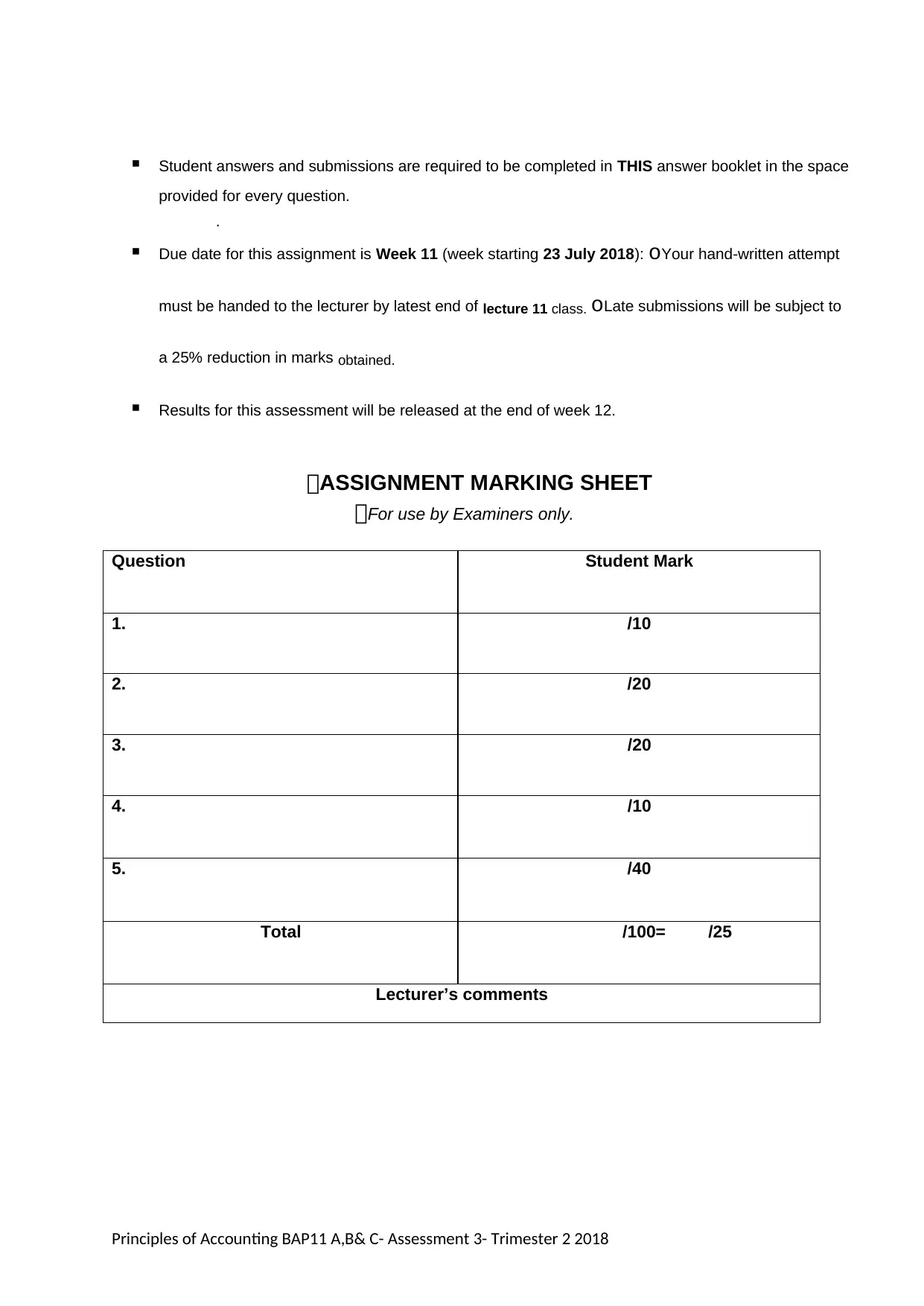
Student answers and submissions are required to be completed in THIS answer booklet in the space
provided for every question.
.
Due date for this assignment is Week 11 (week starting 23 July 2018): oYour hand-written attempt
must be handed to the lecturer by latest end of lecture 11 class. oLate submissions will be subject to
a 25% reduction in marks obtained.
Results for this assessment will be released at the end of week 12.
ASSIGNMENT MARKING SHEET
For use by Examiners only.
Question Student Mark
1. /10
2. /20
3. /20
4. /10
5. /40
Total /100= /25
Lecturer’s comments
Principles of Accounting BAP11 A,B& C- Assessment 3- Trimester 2 2018
provided for every question.
.
Due date for this assignment is Week 11 (week starting 23 July 2018): oYour hand-written attempt
must be handed to the lecturer by latest end of lecture 11 class. oLate submissions will be subject to
a 25% reduction in marks obtained.
Results for this assessment will be released at the end of week 12.
ASSIGNMENT MARKING SHEET
For use by Examiners only.
Question Student Mark
1. /10
2. /20
3. /20
4. /10
5. /40
Total /100= /25
Lecturer’s comments
Principles of Accounting BAP11 A,B& C- Assessment 3- Trimester 2 2018
Paraphrase This Document
Need a fresh take? Get an instant paraphrase of this document with our AI Paraphraser
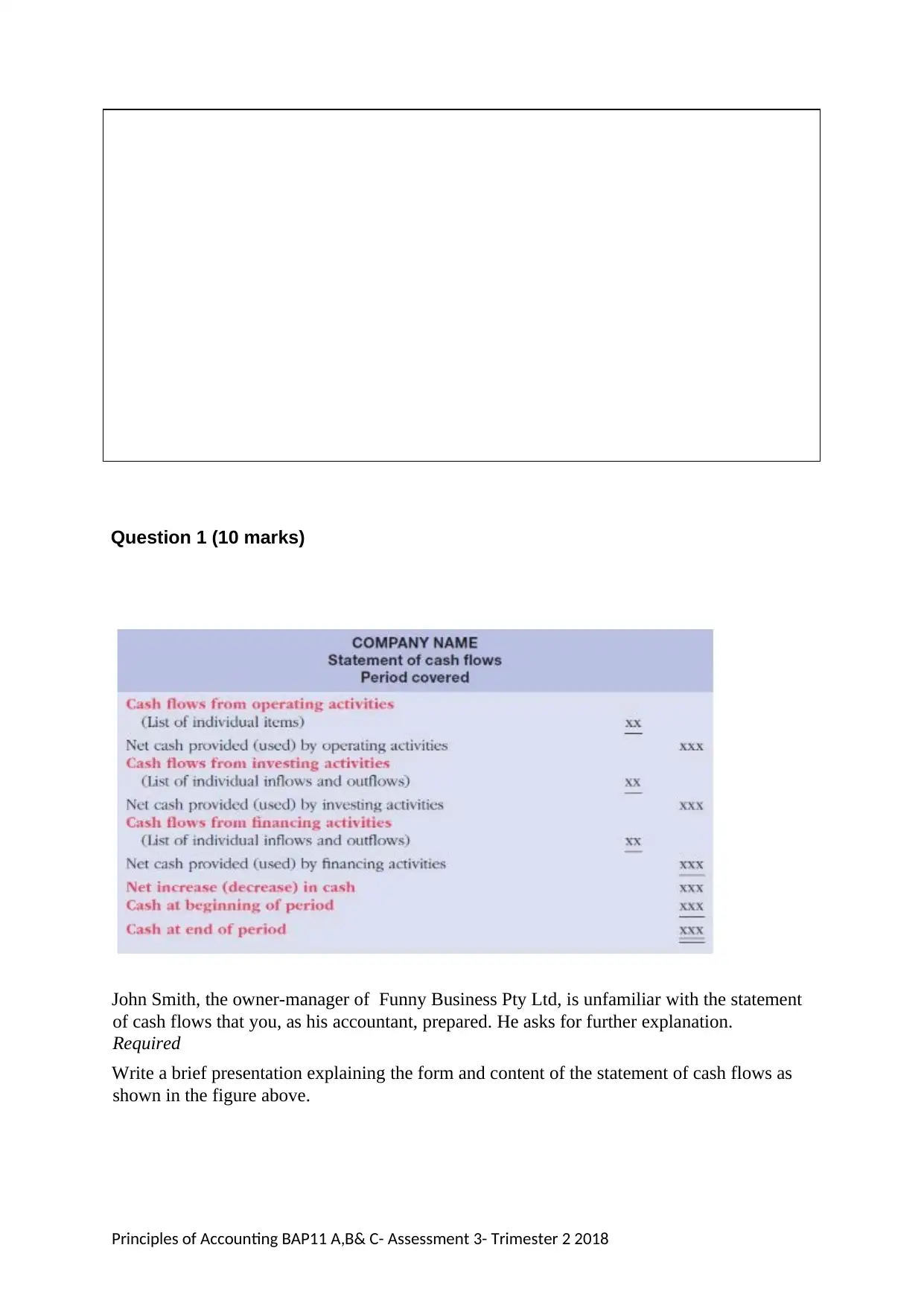
Question 1 (10 marks)
John Smith, the owner-manager of Funny Business Pty Ltd, is unfamiliar with the statement
of cash flows that you, as his accountant, prepared. He asks for further explanation.
Required
Write a brief presentation explaining the form and content of the statement of cash flows as
shown in the figure above.
Principles of Accounting BAP11 A,B& C- Assessment 3- Trimester 2 2018
John Smith, the owner-manager of Funny Business Pty Ltd, is unfamiliar with the statement
of cash flows that you, as his accountant, prepared. He asks for further explanation.
Required
Write a brief presentation explaining the form and content of the statement of cash flows as
shown in the figure above.
Principles of Accounting BAP11 A,B& C- Assessment 3- Trimester 2 2018
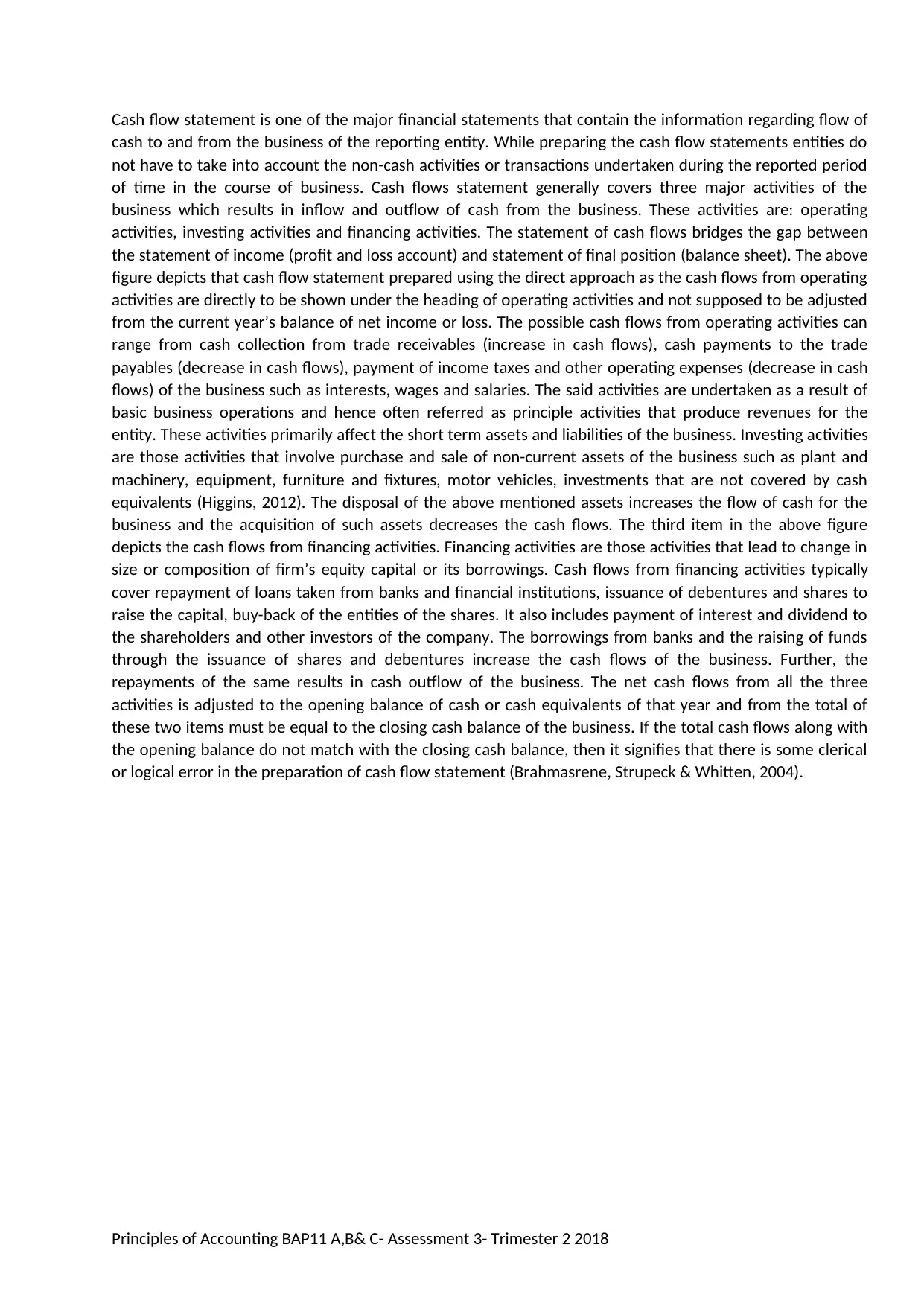
Cash flow statement is one of the major financial statements that contain the information regarding flow of
cash to and from the business of the reporting entity. While preparing the cash flow statements entities do
not have to take into account the non-cash activities or transactions undertaken during the reported period
of time in the course of business. Cash flows statement generally covers three major activities of the
business which results in inflow and outflow of cash from the business. These activities are: operating
activities, investing activities and financing activities. The statement of cash flows bridges the gap between
the statement of income (profit and loss account) and statement of final position (balance sheet). The above
figure depicts that cash flow statement prepared using the direct approach as the cash flows from operating
activities are directly to be shown under the heading of operating activities and not supposed to be adjusted
from the current year’s balance of net income or loss. The possible cash flows from operating activities can
range from cash collection from trade receivables (increase in cash flows), cash payments to the trade
payables (decrease in cash flows), payment of income taxes and other operating expenses (decrease in cash
flows) of the business such as interests, wages and salaries. The said activities are undertaken as a result of
basic business operations and hence often referred as principle activities that produce revenues for the
entity. These activities primarily affect the short term assets and liabilities of the business. Investing activities
are those activities that involve purchase and sale of non-current assets of the business such as plant and
machinery, equipment, furniture and fixtures, motor vehicles, investments that are not covered by cash
equivalents (Higgins, 2012). The disposal of the above mentioned assets increases the flow of cash for the
business and the acquisition of such assets decreases the cash flows. The third item in the above figure
depicts the cash flows from financing activities. Financing activities are those activities that lead to change in
size or composition of firm’s equity capital or its borrowings. Cash flows from financing activities typically
cover repayment of loans taken from banks and financial institutions, issuance of debentures and shares to
raise the capital, buy-back of the entities of the shares. It also includes payment of interest and dividend to
the shareholders and other investors of the company. The borrowings from banks and the raising of funds
through the issuance of shares and debentures increase the cash flows of the business. Further, the
repayments of the same results in cash outflow of the business. The net cash flows from all the three
activities is adjusted to the opening balance of cash or cash equivalents of that year and from the total of
these two items must be equal to the closing cash balance of the business. If the total cash flows along with
the opening balance do not match with the closing cash balance, then it signifies that there is some clerical
or logical error in the preparation of cash flow statement (Brahmasrene, Strupeck & Whitten, 2004).
Principles of Accounting BAP11 A,B& C- Assessment 3- Trimester 2 2018
cash to and from the business of the reporting entity. While preparing the cash flow statements entities do
not have to take into account the non-cash activities or transactions undertaken during the reported period
of time in the course of business. Cash flows statement generally covers three major activities of the
business which results in inflow and outflow of cash from the business. These activities are: operating
activities, investing activities and financing activities. The statement of cash flows bridges the gap between
the statement of income (profit and loss account) and statement of final position (balance sheet). The above
figure depicts that cash flow statement prepared using the direct approach as the cash flows from operating
activities are directly to be shown under the heading of operating activities and not supposed to be adjusted
from the current year’s balance of net income or loss. The possible cash flows from operating activities can
range from cash collection from trade receivables (increase in cash flows), cash payments to the trade
payables (decrease in cash flows), payment of income taxes and other operating expenses (decrease in cash
flows) of the business such as interests, wages and salaries. The said activities are undertaken as a result of
basic business operations and hence often referred as principle activities that produce revenues for the
entity. These activities primarily affect the short term assets and liabilities of the business. Investing activities
are those activities that involve purchase and sale of non-current assets of the business such as plant and
machinery, equipment, furniture and fixtures, motor vehicles, investments that are not covered by cash
equivalents (Higgins, 2012). The disposal of the above mentioned assets increases the flow of cash for the
business and the acquisition of such assets decreases the cash flows. The third item in the above figure
depicts the cash flows from financing activities. Financing activities are those activities that lead to change in
size or composition of firm’s equity capital or its borrowings. Cash flows from financing activities typically
cover repayment of loans taken from banks and financial institutions, issuance of debentures and shares to
raise the capital, buy-back of the entities of the shares. It also includes payment of interest and dividend to
the shareholders and other investors of the company. The borrowings from banks and the raising of funds
through the issuance of shares and debentures increase the cash flows of the business. Further, the
repayments of the same results in cash outflow of the business. The net cash flows from all the three
activities is adjusted to the opening balance of cash or cash equivalents of that year and from the total of
these two items must be equal to the closing cash balance of the business. If the total cash flows along with
the opening balance do not match with the closing cash balance, then it signifies that there is some clerical
or logical error in the preparation of cash flow statement (Brahmasrene, Strupeck & Whitten, 2004).
Principles of Accounting BAP11 A,B& C- Assessment 3- Trimester 2 2018
⊘ This is a preview!⊘
Do you want full access?
Subscribe today to unlock all pages.

Trusted by 1+ million students worldwide
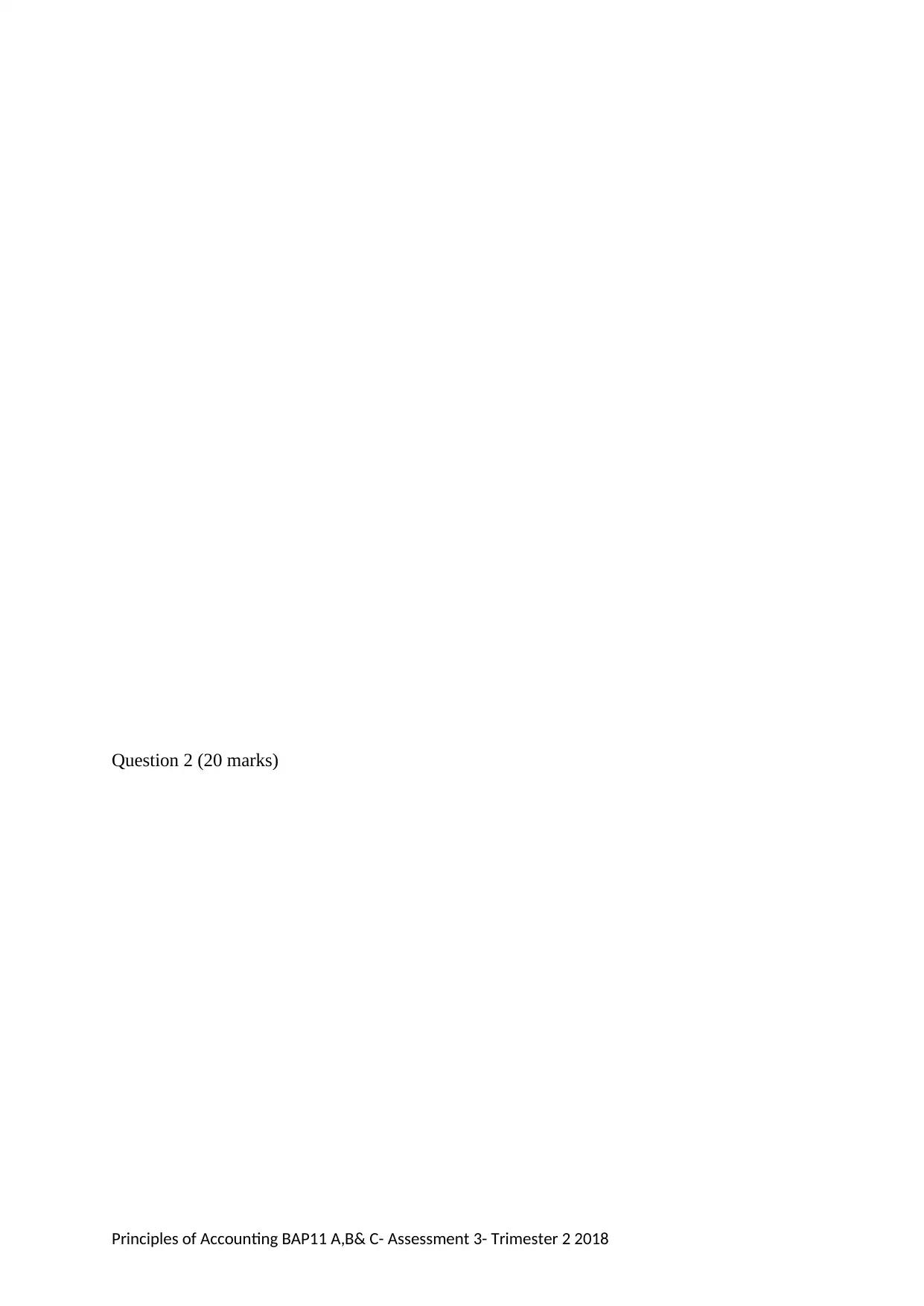
Question 2 (20 marks)
Principles of Accounting BAP11 A,B& C- Assessment 3- Trimester 2 2018
Principles of Accounting BAP11 A,B& C- Assessment 3- Trimester 2 2018
Paraphrase This Document
Need a fresh take? Get an instant paraphrase of this document with our AI Paraphraser
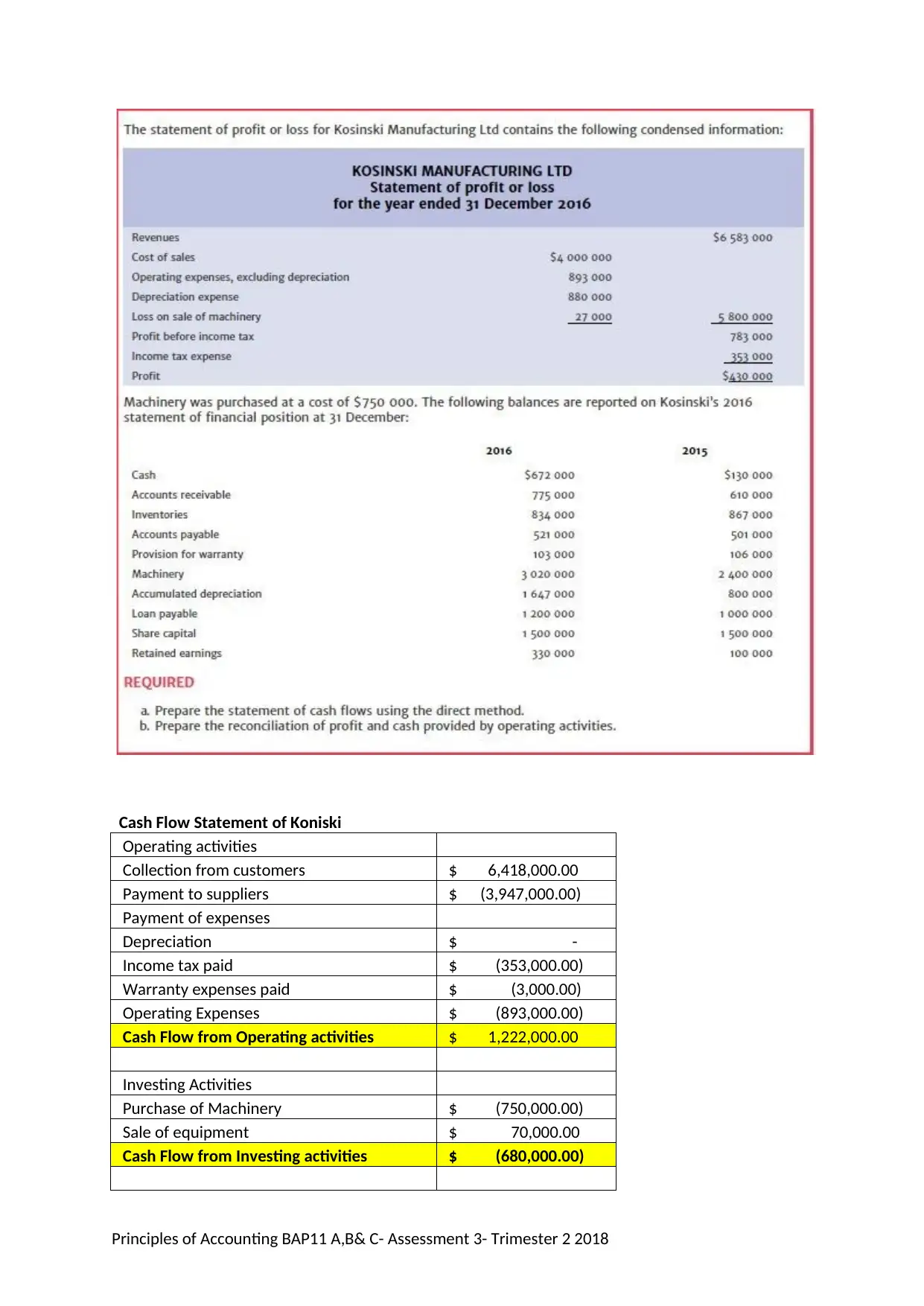
Cash Flow Statement of Koniski
Operating activities
Collection from customers $ 6,418,000.00
Payment to suppliers $ (3,947,000.00)
Payment of expenses
Depreciation $ -
Income tax paid $ (353,000.00)
Warranty expenses paid $ (3,000.00)
Operating Expenses $ (893,000.00)
Cash Flow from Operating activities $ 1,222,000.00
Investing Activities
Purchase of Machinery $ (750,000.00)
Sale of equipment $ 70,000.00
Cash Flow from Investing activities $ (680,000.00)
Principles of Accounting BAP11 A,B& C- Assessment 3- Trimester 2 2018
Operating activities
Collection from customers $ 6,418,000.00
Payment to suppliers $ (3,947,000.00)
Payment of expenses
Depreciation $ -
Income tax paid $ (353,000.00)
Warranty expenses paid $ (3,000.00)
Operating Expenses $ (893,000.00)
Cash Flow from Operating activities $ 1,222,000.00
Investing Activities
Purchase of Machinery $ (750,000.00)
Sale of equipment $ 70,000.00
Cash Flow from Investing activities $ (680,000.00)
Principles of Accounting BAP11 A,B& C- Assessment 3- Trimester 2 2018
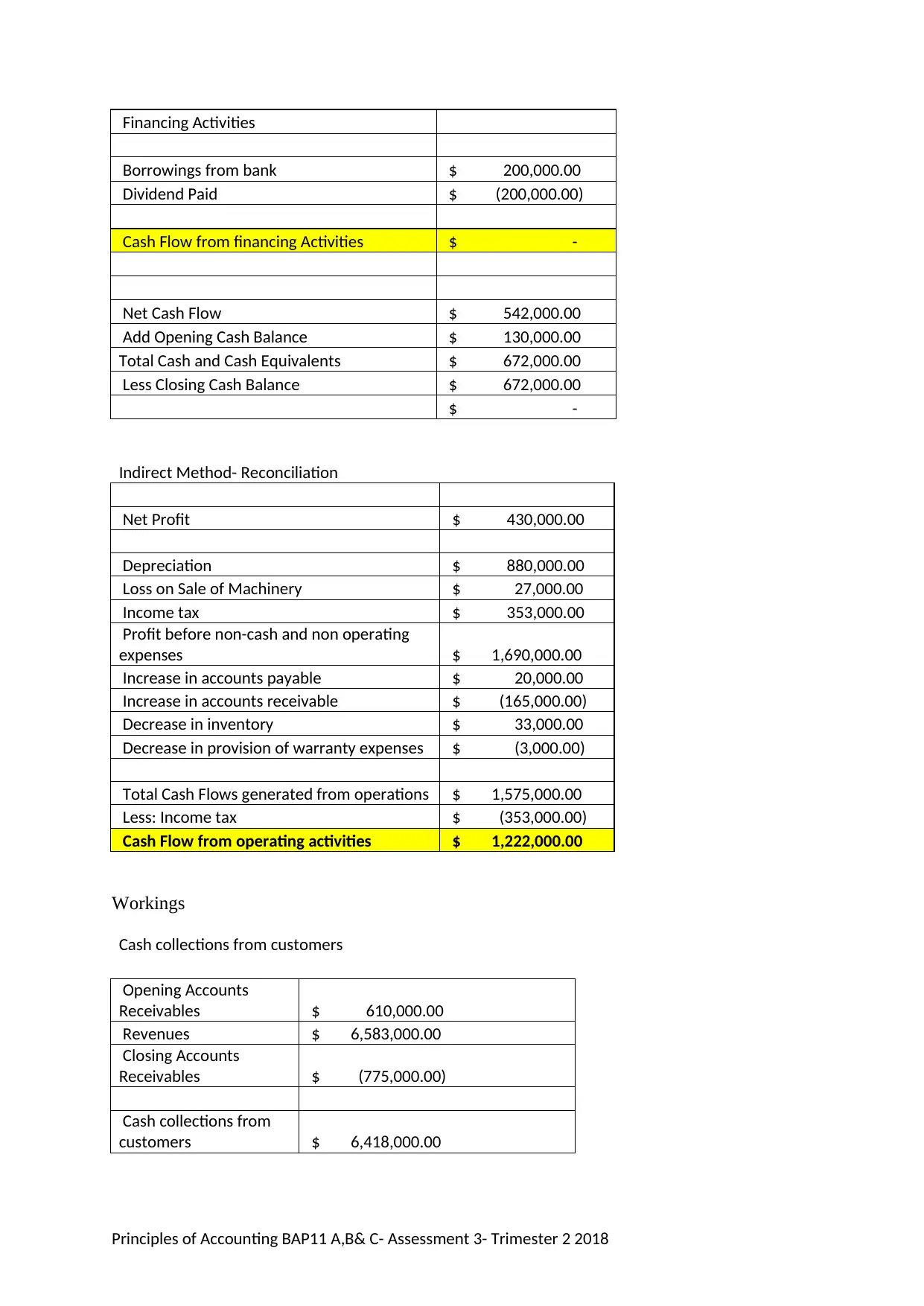
Financing Activities
Borrowings from bank $ 200,000.00
Dividend Paid $ (200,000.00)
Cash Flow from financing Activities $ -
Net Cash Flow $ 542,000.00
Add Opening Cash Balance $ 130,000.00
Total Cash and Cash Equivalents $ 672,000.00
Less Closing Cash Balance $ 672,000.00
$ -
Indirect Method- Reconciliation
Net Profit $ 430,000.00
Depreciation $ 880,000.00
Loss on Sale of Machinery $ 27,000.00
Income tax $ 353,000.00
Profit before non-cash and non operating
expenses $ 1,690,000.00
Increase in accounts payable $ 20,000.00
Increase in accounts receivable $ (165,000.00)
Decrease in inventory $ 33,000.00
Decrease in provision of warranty expenses $ (3,000.00)
Total Cash Flows generated from operations $ 1,575,000.00
Less: Income tax $ (353,000.00)
Cash Flow from operating activities $ 1,222,000.00
Workings
Cash collections from customers
Opening Accounts
Receivables $ 610,000.00
Revenues $ 6,583,000.00
Closing Accounts
Receivables $ (775,000.00)
Cash collections from
customers $ 6,418,000.00
Principles of Accounting BAP11 A,B& C- Assessment 3- Trimester 2 2018
Borrowings from bank $ 200,000.00
Dividend Paid $ (200,000.00)
Cash Flow from financing Activities $ -
Net Cash Flow $ 542,000.00
Add Opening Cash Balance $ 130,000.00
Total Cash and Cash Equivalents $ 672,000.00
Less Closing Cash Balance $ 672,000.00
$ -
Indirect Method- Reconciliation
Net Profit $ 430,000.00
Depreciation $ 880,000.00
Loss on Sale of Machinery $ 27,000.00
Income tax $ 353,000.00
Profit before non-cash and non operating
expenses $ 1,690,000.00
Increase in accounts payable $ 20,000.00
Increase in accounts receivable $ (165,000.00)
Decrease in inventory $ 33,000.00
Decrease in provision of warranty expenses $ (3,000.00)
Total Cash Flows generated from operations $ 1,575,000.00
Less: Income tax $ (353,000.00)
Cash Flow from operating activities $ 1,222,000.00
Workings
Cash collections from customers
Opening Accounts
Receivables $ 610,000.00
Revenues $ 6,583,000.00
Closing Accounts
Receivables $ (775,000.00)
Cash collections from
customers $ 6,418,000.00
Principles of Accounting BAP11 A,B& C- Assessment 3- Trimester 2 2018
⊘ This is a preview!⊘
Do you want full access?
Subscribe today to unlock all pages.

Trusted by 1+ million students worldwide
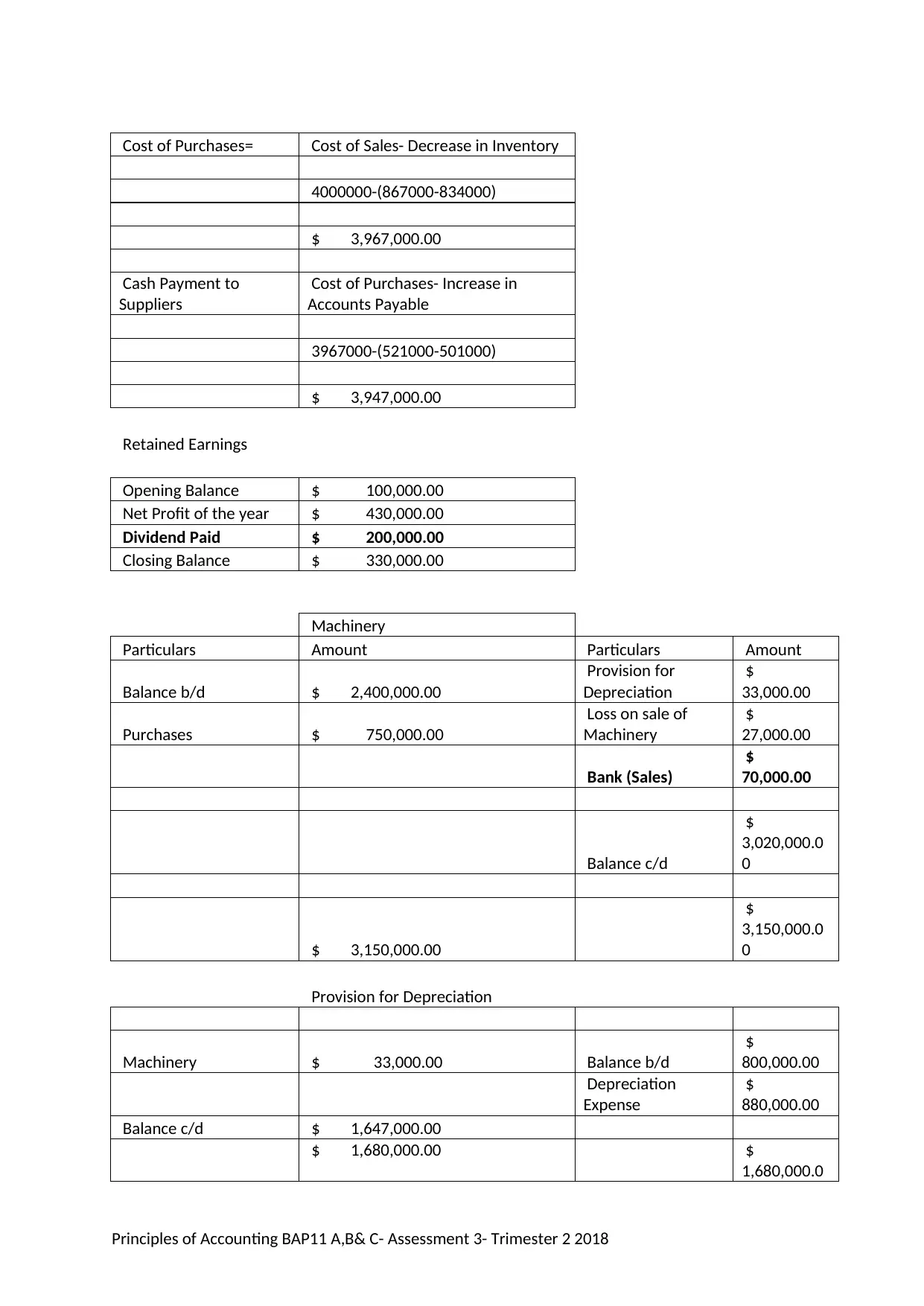
Cost of Purchases= Cost of Sales- Decrease in Inventory
4000000-(867000-834000)
$ 3,967,000.00
Cash Payment to
Suppliers
Cost of Purchases- Increase in
Accounts Payable
3967000-(521000-501000)
$ 3,947,000.00
Retained Earnings
Opening Balance $ 100,000.00
Net Profit of the year $ 430,000.00
Dividend Paid $ 200,000.00
Closing Balance $ 330,000.00
Machinery
Particulars Amount Particulars Amount
Balance b/d $ 2,400,000.00
Provision for
Depreciation
$
33,000.00
Purchases $ 750,000.00
Loss on sale of
Machinery
$
27,000.00
Bank (Sales)
$
70,000.00
Balance c/d
$
3,020,000.0
0
$ 3,150,000.00
$
3,150,000.0
0
Provision for Depreciation
Machinery $ 33,000.00 Balance b/d
$
800,000.00
Depreciation
Expense
$
880,000.00
Balance c/d $ 1,647,000.00
$ 1,680,000.00 $
1,680,000.0
Principles of Accounting BAP11 A,B& C- Assessment 3- Trimester 2 2018
4000000-(867000-834000)
$ 3,967,000.00
Cash Payment to
Suppliers
Cost of Purchases- Increase in
Accounts Payable
3967000-(521000-501000)
$ 3,947,000.00
Retained Earnings
Opening Balance $ 100,000.00
Net Profit of the year $ 430,000.00
Dividend Paid $ 200,000.00
Closing Balance $ 330,000.00
Machinery
Particulars Amount Particulars Amount
Balance b/d $ 2,400,000.00
Provision for
Depreciation
$
33,000.00
Purchases $ 750,000.00
Loss on sale of
Machinery
$
27,000.00
Bank (Sales)
$
70,000.00
Balance c/d
$
3,020,000.0
0
$ 3,150,000.00
$
3,150,000.0
0
Provision for Depreciation
Machinery $ 33,000.00 Balance b/d
$
800,000.00
Depreciation
Expense
$
880,000.00
Balance c/d $ 1,647,000.00
$ 1,680,000.00 $
1,680,000.0
Principles of Accounting BAP11 A,B& C- Assessment 3- Trimester 2 2018
Paraphrase This Document
Need a fresh take? Get an instant paraphrase of this document with our AI Paraphraser
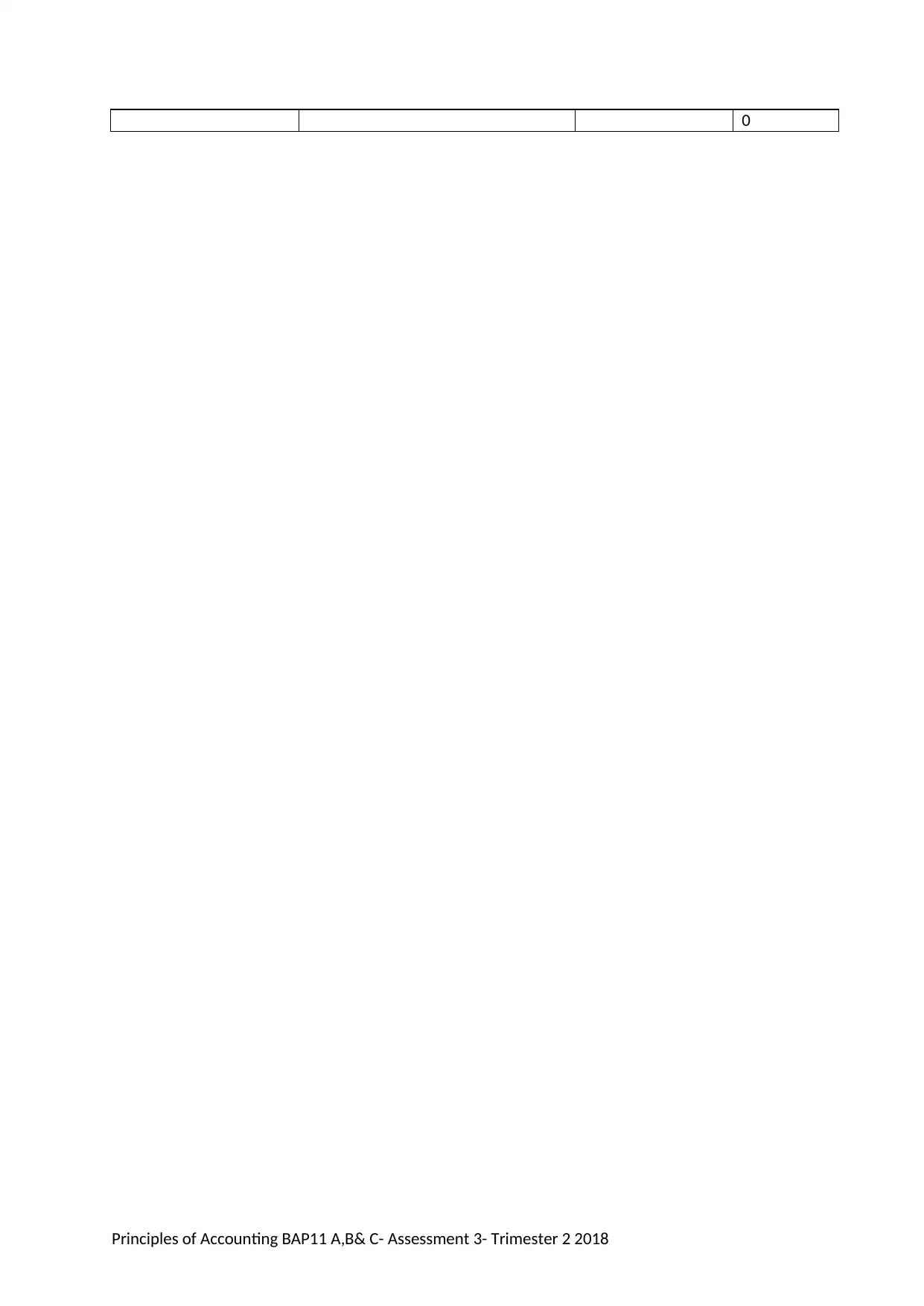
0
Principles of Accounting BAP11 A,B& C- Assessment 3- Trimester 2 2018
Principles of Accounting BAP11 A,B& C- Assessment 3- Trimester 2 2018
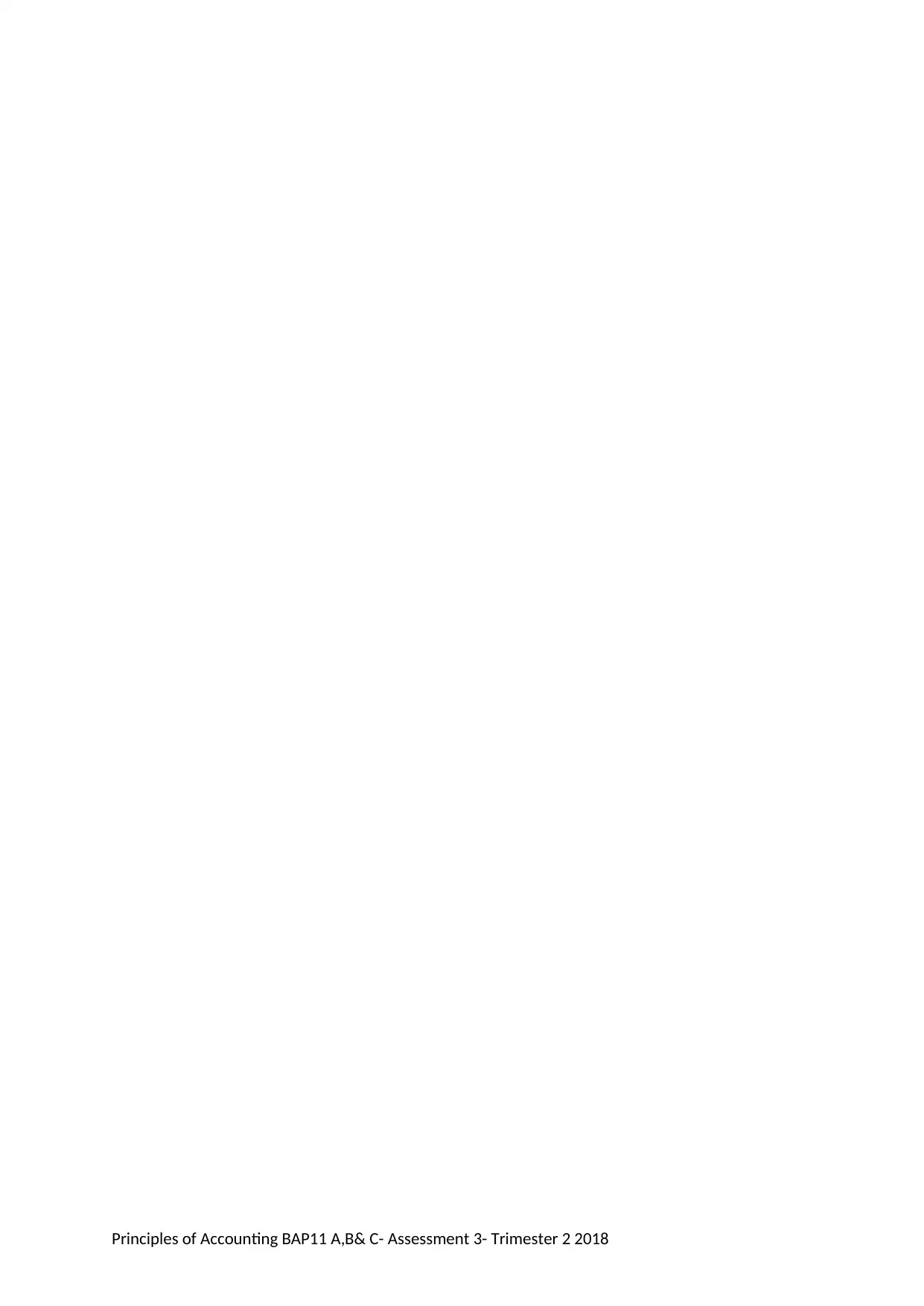
Principles of Accounting BAP11 A,B& C- Assessment 3- Trimester 2 2018
⊘ This is a preview!⊘
Do you want full access?
Subscribe today to unlock all pages.

Trusted by 1+ million students worldwide
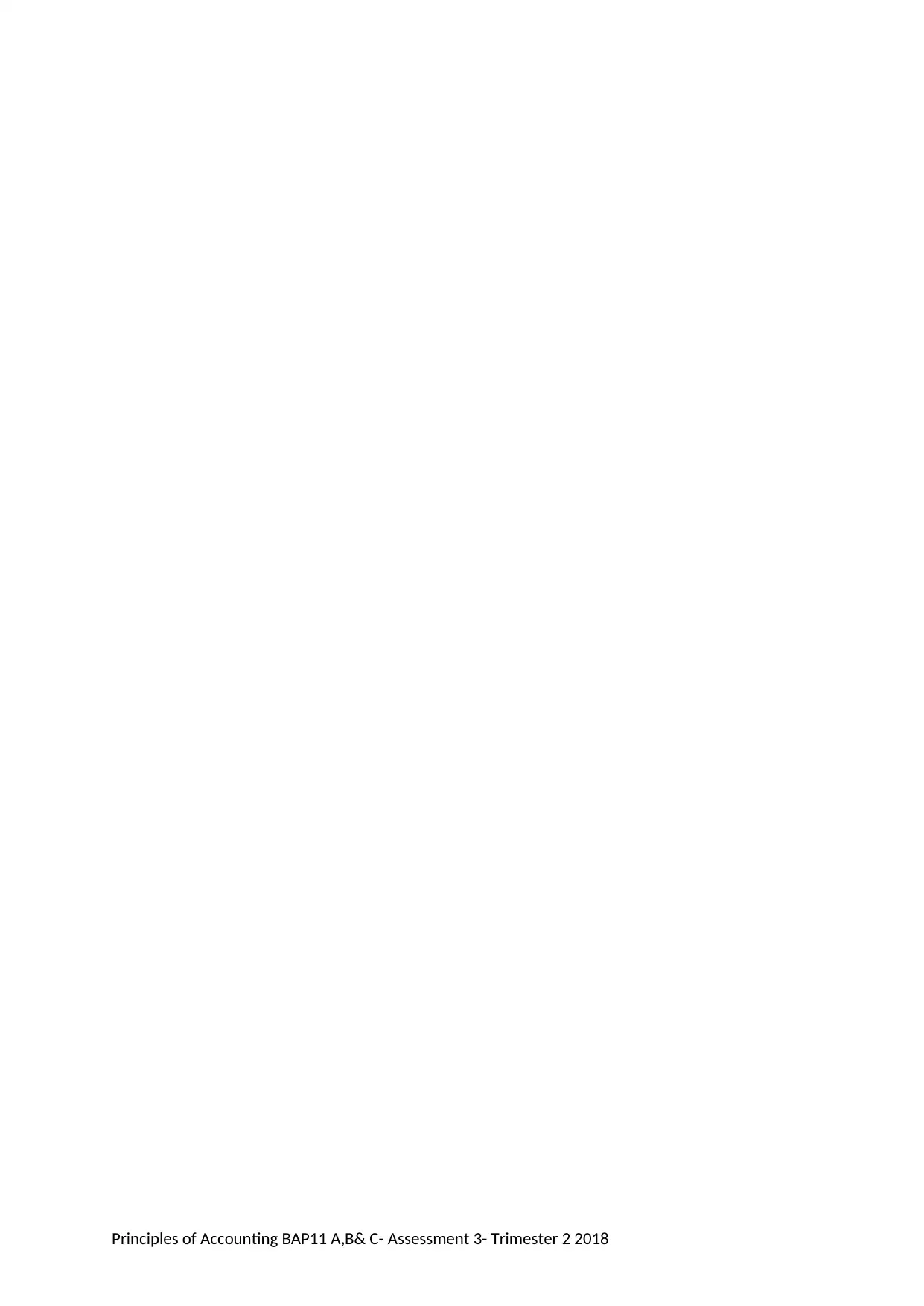
Principles of Accounting BAP11 A,B& C- Assessment 3- Trimester 2 2018
Paraphrase This Document
Need a fresh take? Get an instant paraphrase of this document with our AI Paraphraser
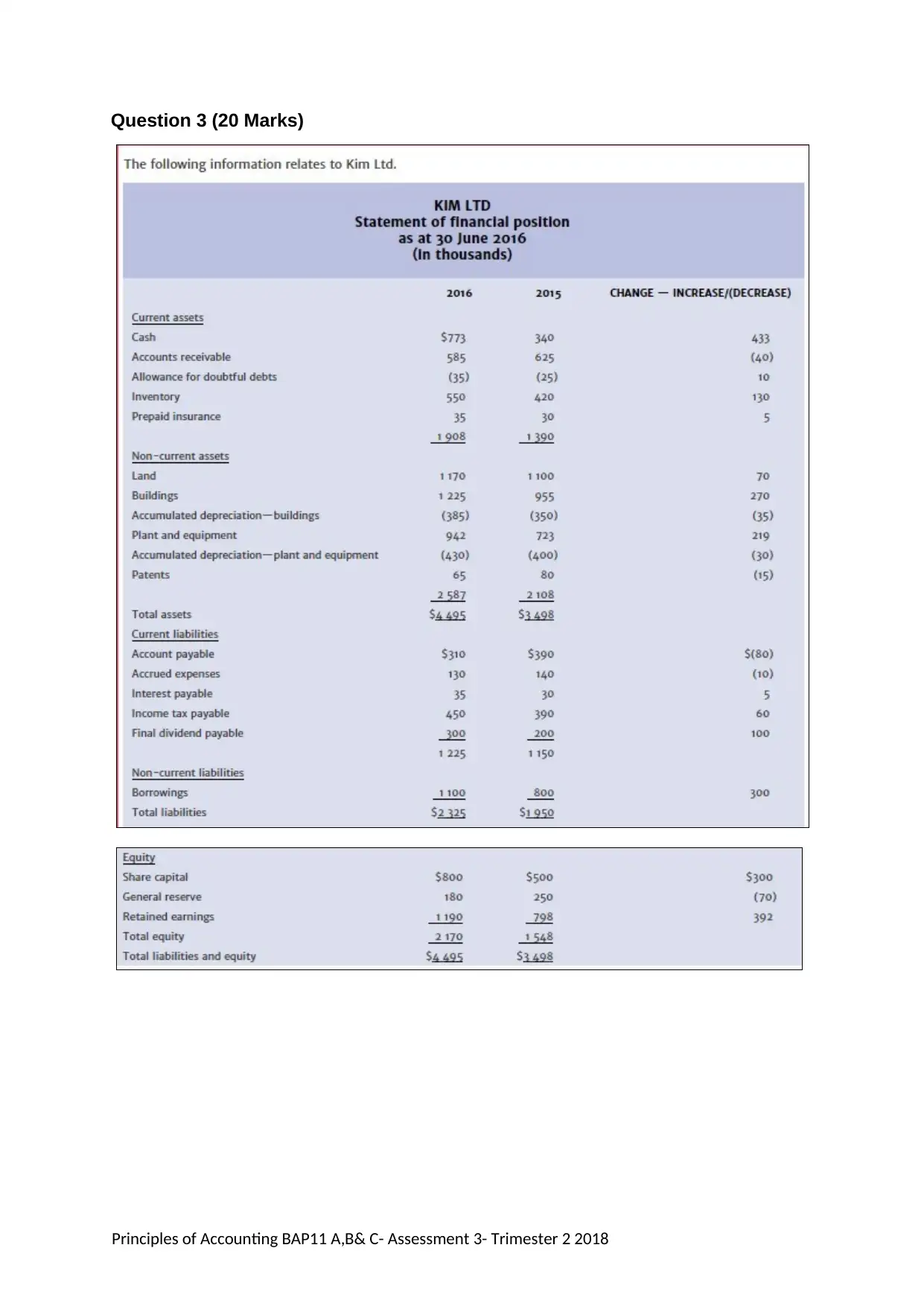
Question 3 (20 Marks)
Principles of Accounting BAP11 A,B& C- Assessment 3- Trimester 2 2018
Principles of Accounting BAP11 A,B& C- Assessment 3- Trimester 2 2018
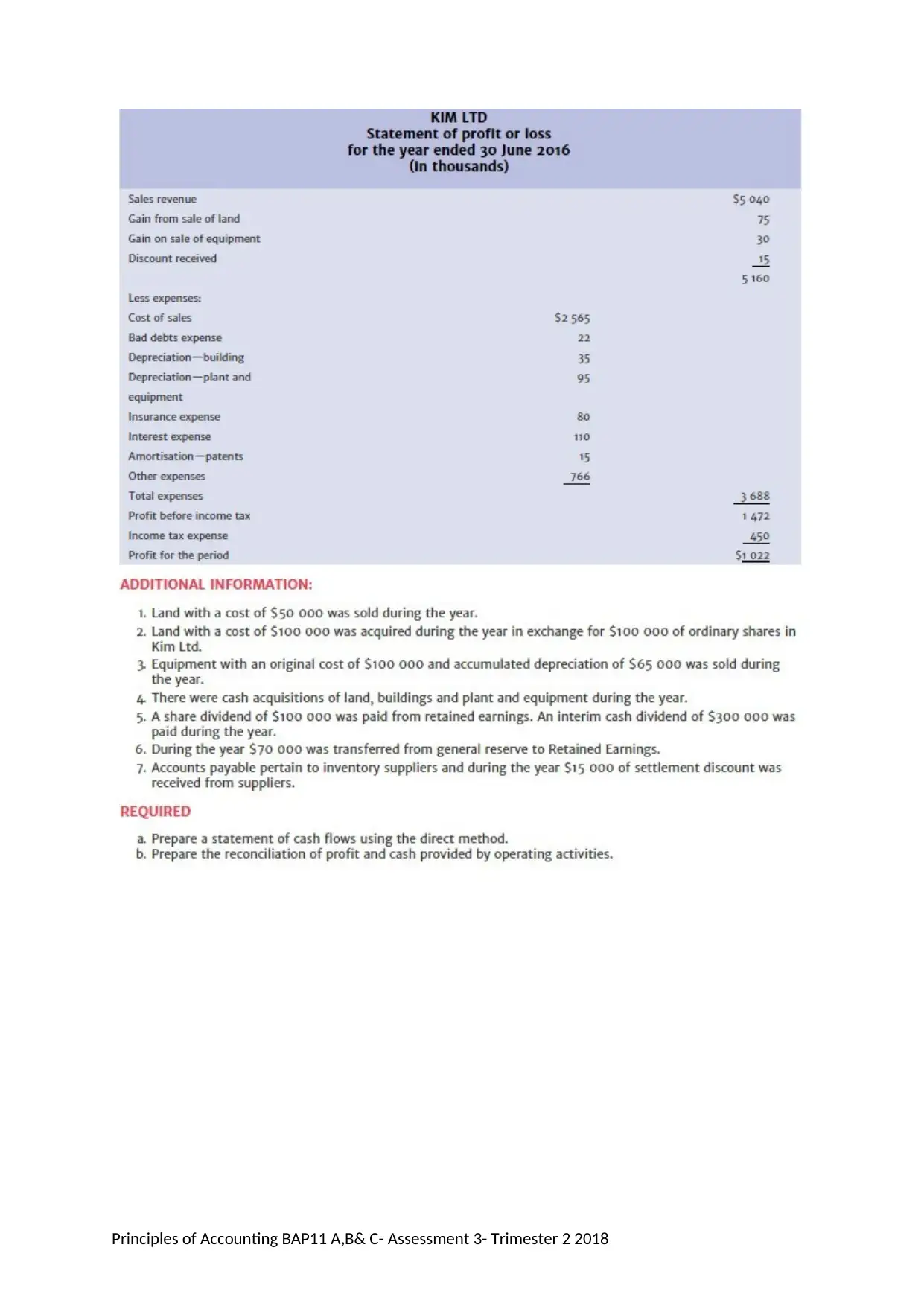
Principles of Accounting BAP11 A,B& C- Assessment 3- Trimester 2 2018
⊘ This is a preview!⊘
Do you want full access?
Subscribe today to unlock all pages.

Trusted by 1+ million students worldwide
1 out of 26
Related Documents
Your All-in-One AI-Powered Toolkit for Academic Success.
+13062052269
info@desklib.com
Available 24*7 on WhatsApp / Email
![[object Object]](/_next/static/media/star-bottom.7253800d.svg)
Unlock your academic potential
Copyright © 2020–2025 A2Z Services. All Rights Reserved. Developed and managed by ZUCOL.




